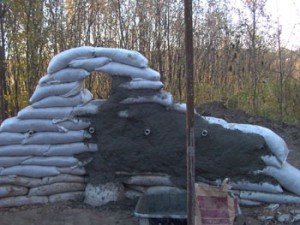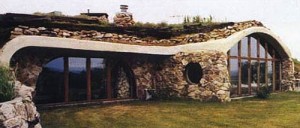The majority of conventional Oxford Brookes-educated architects and home designers will consider me being barking mad to try to unearth the uneasy topic of earthbag buildings, but here we are. Sandbag buildings we’re all familiar with – sandbag walls are great as flood barriers or temporary military buildings. Bullets don’t go through earthbags, don’t ricochet and don’t create shrapnel.

By the way, a single-storey sandbag house can withstand the fiercest earthquake and it is fireproof.
Are Earth Sheltered Buildings Green?

In order to build one properly, you’ll need much more concrete than during a conventional build because it is essential to get the house watertight and make sure the back wall can bear the weight of the Earth. Thus, it might take up to 20 years for your eco-friendly earth sheltered home to become carbon neutral.
Remember that when it comes to embodied energy (grey energy) necessary to produce cement and the total CO2 balance of laying the concrete, for every pound of concrete you use there comes almost a full pound of CO2. That’s the main reason I am convinced that screwpile foundations are the right way forward!
Then there are lighting issues with earth sheltered homes. If we stay true to the very idea of earth sheltered homes, the back of your dwelling will be rather darkish.
But having said that, there are issues with earthbag buildings too. For example, you’re always limited by the size. Although there are some in existence, generally speaking, it is a silly idea to build a multi-storey earthbag house.
Sandbag houses are not entirely green too. You’ll be using lots of sacks. And although the purists preach burlap bags, it makes more sense using the white sugar bags made of polyethylene strips. Rats and bugs are not too keen on eating polyethylene and it is less prone to rotting.
Still, earthbags enable you to build a permanent green house without ever visiting a build store.
So How are Earthbag Buildings Made?
It all starts by digging trenches for foundation. When it comes to foundations of an earthbag building, there are a few ways to approach it. You can pour concrete in the trench, instantly rendering the house non-green; you can use old tyres, fill the gaps with stones or you can use rock-bags for the foundation (bags filled with heavy soil and stones).
You want your earthbag building to be roundish; dome shaped ideally. Although some people treat sandbags like any other conventional building material, there will be folk reminding you that corners and sandbags don’t get well together. I’m inclined to agree with them. Veeery fiddly; you’ll find it hard to get the corners right. Sandbags seem ideal for making dome homes. To get any decent living space within your home you’ll probably want to link/intersect several domes. Building large dome homes from sandbags can be too dangerous.
The finishing of the dome top needs proper planning. Although it is possible to stack the sacks in a pyramidal way so that each sack stops the bottom one from moving by applying its own weight on its neighbour, building safety regulations (and common sense, really) will ask for a sub-structure to support the dome building roof. It can be a frame made of wood, rusty pipes or any other material that is capable of bearing the weight.
Although walls of a finished dome can be left as is, it is highly recommended to apply lime plaster. The roof can be clad with reclaimed slates.
Soil provides an amazing thermal mass so both earthbag and earth sheltered homes will remain cool in summer and keep heat in the winter. It can be a challenge to get a planning permission mainly because of the unconventional look of green buildings. It is very unlikely that they will allow you to build a weird eco-house amidst a neat English terrace, however, the further out of town we go, the easier it is to get a planning permission.
Pics by: http://www.flickr.com/photos/organicarts and Malcolm Wells.

I’m glad to see that earthbag building is getting the attention that it deserves. I built my dome home with earthbags over a decade ago, and can heartily recommend this approach as one of the most ecological ways to go. In fact I am so enthusiastic about it that I have joined with Dr. Owen Geiger to create a website just on this topic: http://www.earthbagbuilding.com. You can find many articles, project pages, videos, a blog, resources, etc. at this site.
In response to your article, I might clarify a few things.
Earthbag houses can be built to resist earthquake damage, but they must be carefully engineered and built with this in mind.
It is possible to combine earthbag building with earth-sheltering. In fact we have several designs that do just that shown at http://dreamgreenhomes.com/styles/earthsheltered/livingroofs.htm
Earthbag buildings do not require a conventional foundation. We usually recommend using rubble trench foundations with the first several rows of bags being filled with gravel.
The most common bags being used for this type of building are polypropylene, often used for agricultural products. These can be purchased as misprints, or found used, so in effect they can be recycled.
An essential part of earthbag building is the barbed wire that is placed between every course of bags. This holds everything together, and greatly enhances the chance of surviving a seismic event.
You can use earthbags to build any shape of house, and that is one of the true advantages of this method. Curved shapes are inherently stronger, but with proper buttressing and reinforcement, rectilinear shapes are quite possible, and many have been built. Once plastered, there is no way to tell that they are not conventionally built, except that the walls are thicker.
Domes can be self-supporting if the bags are not cantilevered too abruptly. Keeping the angle to no more than 60 degrees will usually work. The main trick with domes is waterproofing them; in a damp climate this can be difficult, and require the use of commercial roof sealers.
It is essential to plaster any part of the structure that might receive sunlight, since the UV rays will quickly degrade the polypropylene.
One of the beauties of earthbag building is that the bags can be filled with either a thermal mass material (soil…usually sand and clay mixed) or and insulating material (such as scoria, as I did with my house). That way you can choose the appropriate material depending on where it will be located in the design.
Hi Kelly,
Thank you for your very interesting and valuable comment. I’m glad you’ve gone into some details about building earthbag houses. I’m very keen on expanding this topic; I think I’ll send you an email, if you don’t mind.